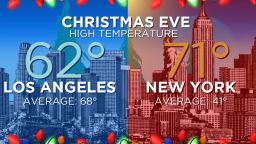Editor’s Note: Adam Sobel, a professor at Columbia University’s Lamont-Doherty Earth Observatory and Fu Foundation School of Engineering and Applied Science, is an atmospheric scientist who studies extreme events and the risks they pose to human society. Sobel is the author of “Storm Surge,” a book about Superstorm Sandy. Follow him on Twitter: @profadamsobel. The opinions expressed are his own.
Story highlights
Adam Sobel: Temperatures in the eastern U.S. are shattering records
Sobel: If record-setting warm spell was happening in the summer, much of the nation would be undergoing a deadly heat wave
The eastern U.S. is warm. Really, really warm. In Central Park, the daytime high on Christmas Eve was 71 degrees Fahrenheit. That’s 8 degrees over the previous record for the day.
Similar records are being set all over the east. And it hasn’t just been a couple days of warm weather; it’s been weeks. Record high temperatures have been set by the thousands during December so far, and the month isn’t over yet. The average December temperature in New York City may reach 14 degrees above average by the end of the month, breaking the previous record, set in 1932, by a couple of degrees.

And it’s not just the heat, it’s the humidity. The warm air is being delivered by southerly winds coming straight from the tropics, and they carry the tropical moisture with them also. The specific humidity – the total amount of water vapor in the air - is breaking records just like the temperature is. The warmth and mugginess are off the charts, separately and together.
Because it’s December, this is just a curiosity, a story about weird weather. If these deviations from average were to happen in the summer, though, and they were to last as long as they have over as widespread an area as they have, it would be a heat wave big enough to cause a major national disaster. There would be many deaths, and most likely blackouts and other infrastructure failures.
Sooner or later, that will happen. So it’s worth understanding what is going on. What is causing this extreme weather event?
No weather event has a unique cause. Every weather event, this one included, has multiple factors that conspire to make it what it is.
The atmosphere is always twisting and turning around, chaotically, with a mind of its own. Any truly extreme event results in large part from that effectively random behavior. For that reason, the specifics of individual extreme events are not predictable far ahead of time – weather forecasting, which is the science of predicting this chaotic component, generally doesn’t work for periods beyond a couple of weeks.
But the climate sets the stage, pushing things in one direction or another and influencing the odds that an extreme event of a given type will occur.
By making the whole planet warmer, human emissions of greenhouse gases increase the odds of a warm event like this one – or its more dangerous hypothetical summer counterpart. If we define the event by specifying a fixed threshold – some number of degrees above average for some number of days, say – the global warming that we’ve already had makes that threshold more likely to be crossed.
Or we can look at it another way: If the specific weather situation – the configuration of the high and low pressure systems, the jet stream, and so forth – were to have been in the the same state 200 years ago as today, it would have still been warm, but it wouldn’t have been quite as warm as today.
Besides human influence, the climate also fluctuates naturally. The most important natural fluctuation this winter is El Niño, a change in the state of both the ocean and the atmosphere in the tropical Pacific that comes every few years or so. The coming and going of El Nino events happens on a pace much faster than that of human-induced climate change, but still much slower and steadier than the day-to-day weather, so it makes sense to think of it as another factor gently nudging the weather in one direction.
In addition to human-induced climate change, the big El Niño currently in place is very likely a significant factor in the present eastern warmth, because of the way it pushes the jet stream around. That’s why a warm December was predicted well ahead of time (though not to the extreme that has happened); we knew through the fall that the El Niño would still be in place now, and what its effects on the U.S. tend to be.
El Niño doesn’t drive the bus by itself any more than global warming does. There’s still a lot of wiggle room for the atmosphere to do its own thing. That’s very apparent in the Pacific Northwest, where I am now. Normally an El Niño makes it dry here, but instead it’s been the rainiest December in history. So the atmosphere’s own variability must be important as well. Each of these factors is present, and likely playing some role in the specific event we see transpiring now.
But just saying that every possible cause matters to an extreme weather event isn’t very satisfying. Which cause matters the most, by how much and in what sense? Can we measure these various influences on the weather with numbers?

In principle, we can. There is now a growing scientific research area that attempts to do this called “extreme event attribution.” Attribution studies try to quantify the influence of specific causes (including, but not limited to human-induced climate change) on some individual weather events, rather than just the larger patterns that climate science has historically been about. The National Academy of Sciences is currently performing a study on this relatively new and rapidly evolving field. (Full disclosure: I’m on the committee that is performing the study.)
This warm event is still ongoing, so attribution studies haven’t been done on it yet. But they will come. The science is reaching the point where we can make real scientific statements about the factors influencing individual weather events like this one, with numbers and statistical confidence intervals and multiple lines of evidence.
So is the current eastern warmth due to human-induced climate change? How about the massive El Niño event that is currently underway in the tropical Pacific? Or is it just an extreme random fluctuation of the weather?
Detailed answers have to await the research to be done. But the basic, general answer, glib but likely true, is: Yes.
Join us on Facebook.com/CNNOpinion.
Read CNNOpinion’s Flipboard magazine.

